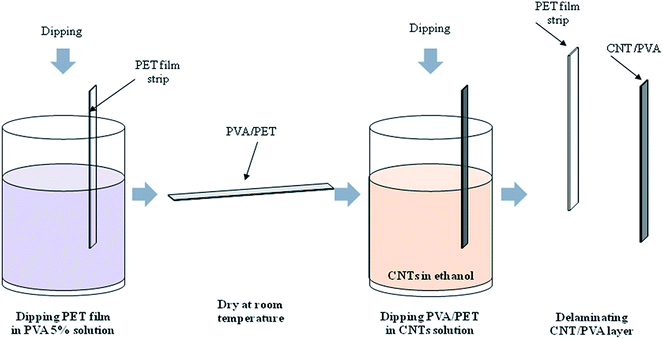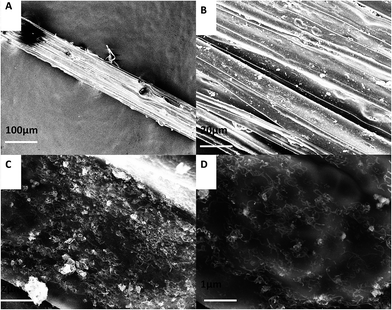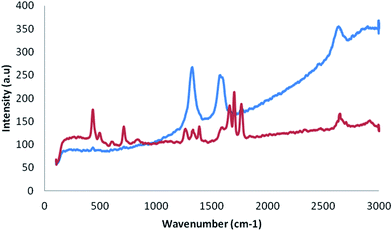A simple/green process for the preparation of composite carbon nanotube fibers/yarns
Abdelaziz Rahy†
a,
Arup Choudhury†a,
Changheon Kima,
Sungwoo Ryub,
Jaewon Hwangb,
Soon Hyung Hongb and
Duck J. Yang*a
aThe Alan G. MacDiarmid NanoTech Institute and Department of Chemistry The University of Texas at Dallas, 800 W. Campbell Road, Richardson, TX 75080, USA. E-mail: djyang@utdallas.edu; Fax: +1 9728832925
bInstitute of NanoCentury, Department of Material Science and Engineering, Korea Advanced Institute of Science, Daejeon 305-701, Republic of Korea
First published on 4th September 2014
Abstract
We report a simple and green process to prepare poly(vinyl alcohol)/carbon nanotube (PVA/CNT) composite fibers having high mechanical properties. This process, an environmentally friendly one with no use of acid or hazardous solvent, produces the composite fibers utilizing a PVA layer pre-coated on a PET film. SEM micrographs indicated that the CNTs are well dispersed in the PVA matrix, and the diameter of the fiber is around 50 μm. Mechanical properties of the composite fiber treated at different thermal annealing conditions are also reported.
1. Introduction
Carbon nanotubes have extremely high strength, high stiffness, low density, good chemical stability, and high thermal and electrical conductivities.1 These superior properties make CNTs very attractive for many structural applications and technologies. Single-walled carbon nanotubes (SWCNTs) have attracted a growing research interest because of their unique combination of properties like electrical conductivity and current-carrying capability similar to copper,2 thermal conductivity higher than diamond,3,4 and mechanical strength higher than any naturally occurring or man-made materials.5–7 Potential applications of carbon nanotube fibers as hydrogen storage,8 actuators,9 microelectrodes10 and supercapacitors11 have been also reported. The CNT fibers or CNT composite fibers are more useful for practical applications than individual CNTs due to their short particle length. Several spinning methods have been reported for fabricating fibers from neat CNTs and from polymer solution containing CNTs such as wet solution spinning,12–22 dry spinning23–34 and gas-state spinning.35–38 Neat CNT fibers and composite carbon nanotube fibers have different properties and therefore different applications. Existing approaches for the production of composite carbon nanotube fibers from solutions are mainly based on wet solution spinning.12–16 In the wet solution spinning approach, the nanotubes are first dispersed by sonication into an aqueous solution of surfactant. The dispersion is then injected into aqueous or acidic aqueous polymer solution.12 When the dispersion comes in contact with the polymer solution, the nanotubes and polymers coagulate to produce the composite fibers. At the final stage of this process, the prepared fibers are subjected to stretching, washing, drying and annealing. In order to eliminate the dispersion problem existing in the solution-based spinning methods, Jiang et al. were the first to develop a dry spinning method by simply drawing a neat CNT yarn from a vertically super-aligned CNT array.34 They found that CNTs could be self-assembled into yarns of up to 30 cm in length. Similarly, Li et al.35 introduced a method for the continuous spinning of neat CNT fibers directly from an aerogel of CNTs formed in CVD reaction zone. The precursor materials include liquid hydrocarbon feedstock with added ferrocene and thiophene. The key requirements for continuous spinning are the formation of CNT aerogel and removal of the product from the reaction zone. Considerable efforts have been made to increase the mechanical properties of polymers by using CNTs as filler.36–41 Vigolo et al.20 reported that composite fibers comprising largely nanotubes can be obtained by a process called polyvinyl alcohol (PVA) coagulation spinning. Dalton et al.42 reported the production of super tough PVA/SWCNT composite fibers with 60 wt% SWCNT content, processed with the aid of a surfactant. They showed the best mechanical performance of PVA/CNT fibers with tensile strength of 1.8 GPa and modulus of 80 GPa. Furthermore, Miaudet et al.22 reported a new hot-drawing process for treating wet spun composite fibers comprised of single or multi-walled carbon nanotubes and PVA matrix with improved the strength. In our earlier work, we have reported the preparation of PVA/MWNT composite fibers by using acid and base treatment to achieve high mechanical properties.43In this study, we report a simpler process for the preparation of PVA/CNT composite fibers. Unlike our early work where we used sulfuric acid treatment, this new fabrication process involves the following steps with no use of acid: (i) dispersion of CNTs in an alcohol such as ethanol, (ii) dipping a PVA polymer layer pre-coated polyester film strip in the CNT homogeneous dispersed solution to coat CNTs on the surface of the polymer layer pre-coated, (iii) delaminating the CNT coated PVA layer from PET strip, and (iv) spinning the delaminated layer to composite fiber by stretching with twisting followed by thermal annealing. This process is not only simple but also environmentally friendly since it has fewer steps and does not require using hazard acid or solvent. In addition, the PVA/CNT composite fibers obtained from this simple and green process yield excellent mechanical properties.
2. Experimental
2.1. Materials
Multi-walled carbon nanotubes (purity 95%, diameter = 10–15 nm, length = 0.1–10 μm, density = 1.7–2.1 g cm−3) were used as received from Zyvex Inc. PVA resin was purchased from Alfa Aesar, whose hydroxyl content (expressed as % polyvinyl alcohol) is about 87–89% and its molecular weight is about 88–97 K. PET film was provided by 3 M, USA. Ethanol was purchased from Merck.2.2. Preparation of CNT/PVA composite fibers
To prepare PVA/CNT composite fiber, PET film strip was first coated with PVA by dipping it into 5% aqueous solution of PVA and dried at room temperature (25 °C). In a separate container, 1 mg of CNT was dispersed in the ethanol (100 ml) medium by ultrasonication for 1 h at room temperature. The PVA-coated PET film was then dipped into the CNT–ethanol suspension. The PVA/CNT composite layer was then delaminated from PET substrate in air. The delaminated film was fabricated into either fiber or yarn, as shown in Fig. 1. The fiber or yarn was stretched over approximately ∼600% without breaking in room temperature and then dried in an air oven at 100 °C for 15 min. The stepwise preparation of PVA/CNT composite fibers is shown in Fig. 1. The fibers were thermally annealed at the range of 130–180 °C for 30 min under tension by taping both ends of each fiber to find an optimum annealing temperature.2.3. Characterization
The tensile properties of PVA/CNT composite fiber (diameter = 50 ± 5 μm) were measured using an Instron 5848 Micro Tester at a loading rate of 1 mm min−1. Using super glue, the fiber ends were mounted on a small piece of paper frame, giving a gauge length of 18.3 mm. After the paper frame was griped mechanically on the tester, it was cut at the sides for tensile testing. To study the tensile performance of the PVA/CNT composite fibers after thermal annealing, the fibers were subjected to heat treatment at different annealing temperatures prior to tensile measurements. The morphology of fiber surface and composite fractured cross-section was characterized by a Zeiss Supra™ 40 variable-pressure field-effect scanning electron microscope at operating voltage of 5 kV. Raman spectra were collected using a JobinYvon HORIBA Raman spectrometer. The thermal behaviors of pure PVA and its composite fibers were determined under non-isothermal conditions. TGA was executed in a TA thermal analyzer (Q 400, USA) under N2 atmosphere (45 ml min−1) at 100–600 °C with heating rate of 10 °C min−1. Samples of about 5.0 mg were measured in an alumina crucible.3. Results & discussion
Fig. 1 shows the fabrication steps of PVA/CNT composite fibers. As PVA indeed interacts strongly with purified nanotubes,44,45 further functionalization of nanotube surface was not required for the preparation of our PVB/CNT composite fibers. When PVA-coated PET film is dipped into the CNT-dispersed ethanol solution, PVA strongly interacts with nanotubes dispersed in ethanol solution and cause their attachment. The CNT coated PVA layer on the film once dipped in ethanol solution was easily peeled off from the film. The diameter of the PVA/CNT fibers can be controlled with the hand-draw method is in the range of 10–100 μm. The fibers when wet were flexible and easily stretchable. The performance of the composite fiber is associated with the homogeneous thickness of CNT layer on PET substrate and their degree of alignment during the stretching and twisting process (Fig. 2).Fig. 3 shows the SEM images of PVA/MWNT fiber. The upper PVA enriched layer is the fiber surface. As shown in the high magnification SEM image in Fig. 3B, the surface of the composite fiber is free from any types of surface contaminations. The fiber surface is rough, and small discontinuity is seen at high magnifications (Fig. 3b). The SEM images in the Fig. 3C and D show the embodiment and the dispersion of MWNTs in the PVA matrix. In Fig. 3C, many small holes on the fiber surface are visible. As shown in the high magnification image in Fig. 3D, the dispersed MWNTs are isolated under the surface PVA layer. Intrinsic properties of the polymer matrix might play an important role in order to achieving homogeneous dispersion of MWNTs in PVA matrix and thus, for the mechanical strength of the composite fiber. Before drying, the fiber or yarn was hand-stretched to approximately 600% in air at room temperature. The hand-stretching might bring the MWNTs in and therefore, enhances the van der Waals forces that improve the load transfer among the CNTs.
Raman spectroscopy can provide unique information about vibrational and electronic properties of a material. In the field of fiber composite materials, the mechanical strain to fibers could result in shifting of Raman bands, which is directly related to the interatomic force constants.46 The Raman spectra of pristine MWNT and PVA/MWNT composite fibers are presented in Fig. 4. The bands are observed at 1341 cm−1 (D band) and 1592 cm−1 (G band), corresponding to amorphous carbon impurities and carbon nanotubes, respectively.47 Raman bands of the MWNTs can be seen clearly in the composite fiber, which is due to the resonance effect which enhances the signal greatly.47 It was noted the D band intensity decreased significantly in the composite fiber compared to that in the starting MWNT powder, indicating that the rigorous ultrasonication, which exfoliated the nanotubes efficiently, did not damage the sidewall structure of the nanotubes.
The mechanical properties of PVA/CNT composite fibers before and after thermal annealing were studied. The tensile strength and Young's modulus of the PVA/MWNT composite fiber are recorded 0.9 GPa and 35 GPa. The effects of thermal annealing on the stress–strain behavior of the PVA/MWNT composite fibers are seen in Fig. 5. The tensile properties of the PVA/MWNT composite fibers before and after thermal annealing are presented in Table 1. Based on the annealing study, the best results were obtained at 160 °C; 1.9 GPa tensile strength and 117 GPa Young's modulus. PVA matrix is a semi-crystalline polymer having hydroxyl group in each repeating unit. These hydroxyl groups might be cross-linked during thermal annealing at 160 °C and thus enhanced mechanical strength of the composite fibers. The increase in PVA crystallinity after thermal annealing might also be the reason for the improvement of the mechanical properties of the fiber composites.22,41,47 The use of alcohol as a solvent also resulted in better improvement in the tensile strength of the composite fiber.41 As observed from stress–strain pattern in Fig. 5, the nanocomposites showed small extent of plastic deformation, which might be due to little number of CNT aggregation that act as stress concentrators. As the annealing temperature increase, the yield stress of the nanocomposites increase indicating lower plastic deformation. The high temperature annealing could improve the dispersion of CNTs in the PVA matrix, i.e., lower the aggregation of CNTs. The thermal annealing could also suppress the formation of voids and consequently improve the tensile properties of the composite fiber.
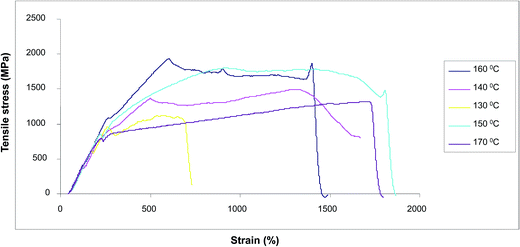 | ||
| Fig. 5 The effects of thermal annealing on the stress–strain behavior of the PVA/MWCNT composite fibers. | ||
| Annealing temperature (°C) | Tensile strength (GPa) | Young's modulus (GPa) |
|---|---|---|
| 25 (control) | 0.9 | 35 |
| 130 | 1.9 | 76 |
| 140 | 1.6 | 81 |
| 150 | 1.1 | 111 |
| 160 | 1.9 | 117 |
| 170 | 1.8 | 94 |
| 180 | 1.7 | 92 |
We are convinced that the best composite fiber could be made not only by achieving a good dispersion and orientation of CNTs in the fiber body, but also having good interaction between the matrix polymer and CNTs. Additionally, thermal annealing could drive polymer chains into ordered (crystalline) conformations, depending on interacting chemical functional groups, structure, and stereochemistry of the polymer.48
Fig. 6a and b show SEM images of the cross-section of a MWNT/PVA fiber before and after annealing at 160 °C for 30 min. It was observed that the voids were reduced and fiber diameter decreased after heat treatment. The reduced fiber diameter for the composite fibers was therefore due to elimination of the voids as well as cross-linking of the PVA matrix. Therefore, eliminating voids and further cross-linking yielded to improve mechanical properties. Additionally, at the temperature above its glass transition temperature (Tg), the mobility of polymer chains increased to further enhance molecular orientation. For example, polyvinyl alcohol –(CH2CHOH)n– crystallizes upon thermal annealing. For a PVA sample with only 1–2% water content, annealing at 90 °C for up to 10 hours yields approximately 38% crystallinity, whereas heating PVA to 200 °C for a few minutes produces approximately 60% crystallinity. PVA is somewhat special in that crystallization can occur in the atactic form. This attributes to hydrogen atoms and hydroxyl groups (–OH) having roughly similar sizes, which allows the close, regular packing of chains. Strong hydrogen bonding between –OH groups on neighboring chains also tends to hold the molecules in a regular structure despite the lack of stereo-regularity.49
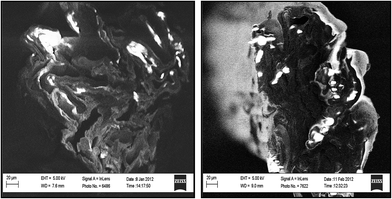 | ||
| Fig. 6 SEMs of cross section of MWNT/PVA composite fiber: (A) before annealing (control), (B) after annealing at 160 C for 30 min. | ||
We believe the reasons why we achieved excellent mechanical properties are that our process: (1) uses no surfactant to disperse CNTs in alcohol solvent. The surfactant molecules positioned at interfacial surfaces between polymer matrix and CNT nanotubes will play a role as a lubricant so no surfactant use will better for higher adhesion between them and (2) yields elimination of voids and further crosslinking of matrix polymer. Proper annealing yields a crystallinity increase of the PVA molecules which also enhance mechanical properties.22,41,47 The van der Waals forces make dispersion of CNTs in PVA polymer difficult because of the aggregation of the CNTs, and voids within the body of fiber as well as little alignment among the CNTs in fiber if occurred will also weaken the mechanical properties. Our new processes overcame the potential weakening factors.
4. Summary
In summary, we discovered a simple process based on a new concept of CNT composite fiber fabrication. This process produces composite CNT fibers simply utilizing CNTs-coated-PVA polymer-layer coated on a PET film. This process is far simpler and greener, and yields much higher mechanical properties compared to the previous processes we reported. This simple and environmentally friendly process can have a great potential to become a commercial process in producing mechanically outstanding composite fibers/yarns. Utilizing this new method, we now are continuing a series of research to find a best matrix polymer, a best combination of different CNTs with the polymer, and a best annealing condition to improve the mechanical properties further. The special structure, as well as mechanical properties could imply potential applications of these fibers in automobile sector.Acknowledgements
The authors gratefully acknowledge the financial support from the Center for Nanostructured Material Technology (CNMT) and Korea Advanced Institute of Science and Technology (KAIST) in Korea.References
- S. J. Tans, M. H. Devoret, H. J. Dai, A. Thess, R. E. Smalley, L. J. Geerligs and C. Dekker, Nature, 1997, 386, 474 CrossRef CAS.
- J. Hone, M. C. Llaguno, N. M. Nemes, A. T. Johnson, J. E. Fischer, D. A. Walters, M. J. Casavant, J. Schmidt and R. E. Smalley, Appl. Phys. Lett., 2000, 77, 666 CrossRef CAS PubMed.
- S. Berber, Y. K. Kwon and D. Tomanek, Phys. Rev. Lett., 2000, 84, 4613 CrossRef CAS.
- J. Hone, M. Whitney, C. Piskoti and A. Zettl, Phys. Rev. B: Condens. Matter Mater. Phys., 1999, 59, 2514 CrossRef.
- A. Krishnan, E. Dujardin, T. W. Ebbesen, P. N. Yianilos and M. M. Treacy, Phys. Rev. B: Condens. Matter Mater. Phys., 1998, 58, 14013 CrossRef CAS.
- M. B. Nardelli, B. I. Yakobson and J. Bernholc, Phys. Rev. Lett., 1998, 81, 4656 CrossRef CAS.
- R. H. Baughman, A. A. Zakhidov and A. A. de Heer, Science, 2002, 297, 787 CrossRef CAS PubMed.
- D. Leonard, J. L. Hudson, H. Fan, R. Booker and L. J. Simpson, J. Am. Chem. Soc., 2009, 131, 723 CrossRef PubMed.
- G. M. Spinks, S. R. Shin, G. G. Wallace and P. G. Whitten, Sens. Actuators, B, 2007, 121, 616 CrossRef CAS PubMed.
- C. Lynam, W. Grosse and G. G. Wallace, J. Electrochem. Soc., 2009, 156, 117 CrossRef PubMed.
- B. Dalton, S. Collins, J. Razal, E. Munoz and V. H. Ebron, J. Mater. Chem., 2004, 14, 1–3 RSC.
- W. Neri, M. Maugey, P. Miaudet, A. Derre, C. Zakri and P. Poulin, Macromol. Rapid Commun., 2006, 27, 1035 CrossRef CAS PubMed.
- J. N. Barisci, M. Tahhan, G. G. Wallace, S. Badaire, T. Vaugien, M. Maugey and P. Pouli, Adv. Funct. Mater., 2004, 14, 133 CrossRef CAS PubMed.
- C. Lynman, W. Grosse and G. G. Wallace, J. Electrochem. Soc., 2009, 156, 117 Search PubMed.
- J. M. Razal, K. J. Gilmore and G. G. Wallace, Adv. Funct. Mater., 2008, 18, 61 CrossRef CAS PubMed.
- C. Lynman, W. Grosse and G. G. Wallac, Adv. Mater., 2007, 19, 1244 CrossRef PubMed.
- J. Steinmetz, M. Glerup, M. Paillet, P. Bernier and M. Holzinger, Carbon, 2005, 43, 2397 CrossRef CAS PubMed.
- L. M. Ericson, H. Fan, H. Peng, V. A. Davis, V. W. Zhou and J. Sulpizio, Science, 2004, 305, 1447 CrossRef CAS PubMed.
- M. E. Kozlov, R. C. Capps, W. M. Sampson, V. H. Ebron, J. P. Ferraris and R. H. Baughman, Adv. Mater., 2005, 17, 614 CrossRef CAS PubMed.
- B. Vigolo, A. Penicaud, C. Coulon, C. Sauder and R. Pailler, Science, 2000, 290, 1331 CrossRef CAS.
- E. Munoz, D. S. Suh, S. Collins, M. Selvidge, A. B. Dalton, B. G. Kim and J. M. Razal, Adv. Mater., 2005, 17, 1064 CrossRef CAS PubMed.
- P. Miaudet, S. Badaire, M. Maugey, A. Derre, V. Pichot and P. Pichot, Nano Lett., 2005, 11, 2212 CrossRef PubMed.
- L. Ci, N. Punbusayayakul, J. Wei, R. Vajtai, S. Talapatra and P. M. Ajayan, Adv. Mater., 2007, 19, 1719 CrossRef CAS PubMed.
- S. J. Zhang, L. Zhu, M. L. Minus, H. G. Chae, S. Jagannathan, C. P. Wong and J. Kowalik, J. Mater. Sci., 2008, 43, 4356–4362 CrossRef CAS.
- L. Zheng, X. Zhang, Q. Li, S. B. Chikkannanavar, Y. Li and Y. Zhao, Adv. Mater., 2007, 19, 2567 CrossRef CAS PubMed.
- M. Zhang, S. Fang, A. A. Zakhidov, S. B. Lee, A. E. Lee and A. Aliev, Science, 2005, 309, 1215 CrossRef CAS PubMed.
- H. G. Chae and S. Kumar, Science, 2008, 319, 908 CrossRef CAS PubMed.
- X. Zhang, Q. Li, Y. Tu, Y. Li, J. Y. Coulter and L. Zheng, Small, 2007, 3, 244 CrossRef CAS PubMed.
- B. Vigolo, P. Poulin, M. Lucas, P. Launois and P. Bernier, Appl. Phys. Lett., 2002, 81, 1210 CrossRef CAS PubMed.
- X. Zhang, Q. Li, T. G. Holesinger, P. N. Arendt, J. Huang and P. D. Kirven, Adv. Mater., 2007, 19, 4198 CrossRef CAS PubMed.
- M. Zhang, K. R. Atkinson and R. H. Baughman, Science, 2004, 306, 1358 CrossRef CAS PubMed.
- X. Zhang, K. Jiang, C. Feng, P. Liu, L. Zhang and J. Kong, Adv. Mater., 2006, 18, 1505 CrossRef CAS PubMed.
- S. Zhang, L. Zhu, M. L. Minus, H. G. Chae, S. Jagannathan and C. P. Wong, J. Mater. Sci., 2008, 43, 4356 CrossRef CAS.
- K. Jiang, Q. Li and S. Fan, Nature, 2002, 419, 801 CrossRef CAS PubMed.
- Y. L. Li, I. A. Kinloch and A. Windle, Science, 2004, 304, 276 CrossRef CAS PubMed.
- S. Kumar, D. T. Dang, F. E. Arnold, A. R. Bhattacharyya, G. B. Min and X. Zhang, Macromolecules, 2002, 35, 9039 CrossRef CAS.
- P. Xue, K. H. Park, X. M. Tao, W. Chen and X. Y. Cheng, Compos. Struct., 2007, 78, 271 CrossRef PubMed.
- M. L. Minus, G. H. Chae and S. Kumar, Polymer, 2006, 47, 705 CrossRef PubMed.
- X. Zhang, T. Liu, T. V. Sreekumar, S. Kumar, X. Hu and K. Smith, Polymer, 2004, 45, 8801 CrossRef CAS PubMed.
- B. G. Min, G. H. Chae, L. M. Minus and S. Kumar, Funct. Compos. Carbon Nanotubes Appl., 2009, 43 CAS.
- I. J. Beyerlein, P. K. Porwal, Y. T. Zhu, K. Hu and X. F. Xu, Nanotechnology, 2009, 20, 485702 CrossRef CAS PubMed.
- A. B. Dalton, S. Collins, E. Munoz, J. M. Razal, V. H. Ebron and J. P. Ferraris, Nature, 2003, 423, 703 CrossRef CAS PubMed.
- A. Rahy, C. Kim, S. Ryu, J. Hwang, S. H. Hong and D. J. Yang, Novel and versatile process for the preparation of polyvinyl alcohol composite carbon nanotube fibers/yarns, IEEE Nanotechnol. Mater. Devices Conf., 2011, 18–21 Search PubMed.
- C. Mercader, V. Denis-Lutard, S. Jestin, M. Maugey, A. Derré and C. Zakri, J. Appl. Polym. Sci., 2001, 125, E191 CrossRef PubMed.
- X. Z. Xu, A. J. Uddin, K. Aoki, Y. Gotoh, T. Saito and M. Yumura, Carbon, 2010, 48, 1977 CrossRef CAS PubMed.
- M. Motta, Y. L. Li, I. Kinloch and A. Windle, Nano Lett., 2005, 8, 1529 CrossRef PubMed.
- K. V. Mitra, W. M. Risen and R. H. Baughman, J. Chem. Phys., 1977, 66, 2731 CrossRef PubMed.
- M. R. Khan, Y. Gotoh, H. Morikawa, M. Miura and Y. Fujimori, Carbon, 2007, 45, 1035 CrossRef CAS PubMed.
- J. Su, Q. Wang, R. Su, K. Wang, Q. Zhang and Q. Fu, J. Appl. Polym. Sci., 2008, 107, 4070 CrossRef CAS PubMed.
Footnote |
| † These authors contributed equally to this work |
| This journal is © The Royal Society of Chemistry 2014 |

